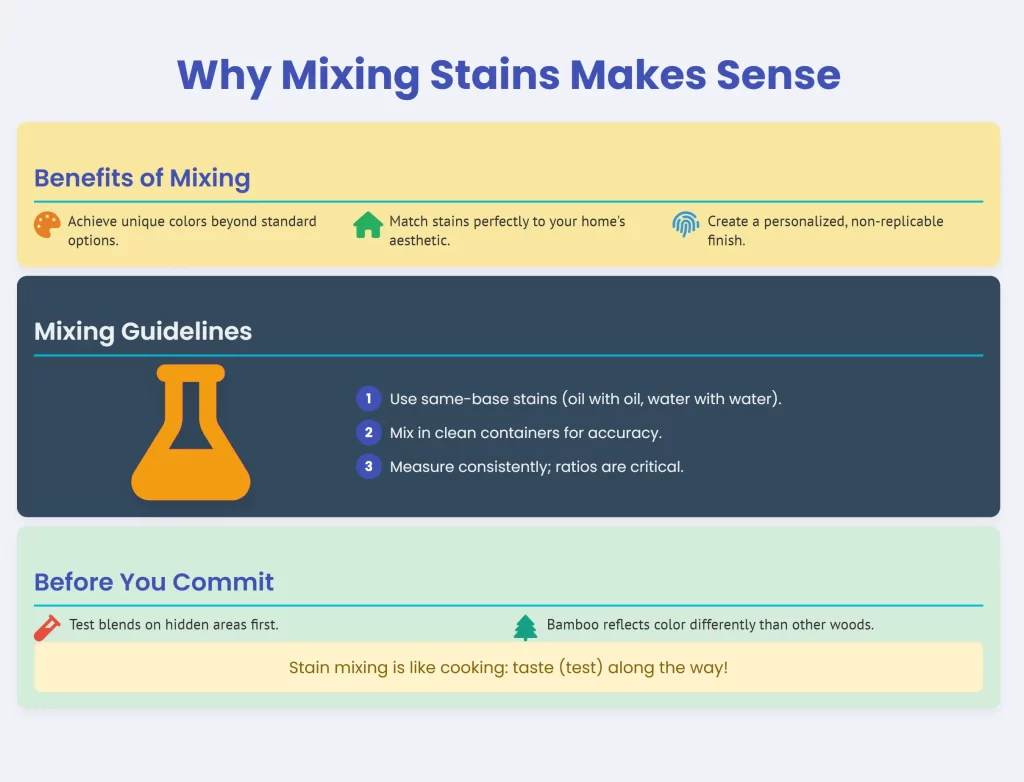This post may contain affiliate links, which means I may receive a commission for purchases made through the links. I will only recommend products that I have personally used! Learn more on my Disclosure page!
Bamboo never asks to be ordinary. Its strength, its lightness, its sustainable soul—all suggest adaptability. Yet when most people stain it, they default to catalog shades: light golden, medium pecan, dark walnut. Safe, yes. But what if your table deserves a color no store has bottled? What if your bamboo bed frame asks for a tone that feels unmistakably yours?
If you want full mastery across sanding, staining, creative blends, and sealing, the complete path lives inside The Bamboo Staining Bible. What follows shows you how mixing stains becomes art, but the guide ties every chapter together.
And if you haven’t yet prepared your bamboo surface, take a moment to step into how to sand bamboo furniture properly. Good sanding is the silent partner of successful stain mixing.
Why mixing stains makes sense

Every home feels unique. Painted walls, curtains that flow differently in daylight, wooden floors with hues shifting under lamps. Standard stain colors often fall short of blending seamlessly.
Mixing offers freedom. A touch of espresso added to golden oak warms it beyond catalog limitations. A drizzle of gray deepens chestnut into a modern neutral. Two equal parts crimson plus dark walnut yield a cherry warmth few can replicate.
Mixes let bamboo tell your home’s story—not a hardware store’s sample board.
What to know before blending
Before you unscrew the lids, gather what is needed:
- Two or more compatible stains (oil‑based with oil‑based, water‑based with water‑based).
- Mixing jars.
- Measuring spoons or syringes for precise ratios.
- Clean brushes.
And do not underestimate the value of tools. A simple orbital sander refines surfaces so colors shine. A sturdy wood finish brush ensures even application. Even reusable mason jars for stain keep your blends consistent batch to batch.
Data Table: Example Custom Bamboo Stain Mixes (2025 Tested)
| Blend Components | Ratio | Resulting Tone | Ideal Use Case | Longevity Indoors* | Longevity Outdoors** |
|---|---|---|---|---|---|
| Golden Oak + Espresso | 2:1 | Rich warm brown | Dining tables, accent chairs | 7–8 years | 2–3 years w/ sealer |
| Crimson + Dark Walnut | 1:1 | Deep cherry red | Bedroom headboards | 8 years | 3 years |
| Gray + Espresso | 1:1 | Smoky modern neutral | Coffee tables, urban living | 6–7 years | 2 years |
| Whitewash + Golden Oak | 1:2 | Pale honey‑silver sheen | Minimalist styled stools | 6 years | 2 years |
*Estimates pulled from 2023–2025 wood finishing durability reports
**Assuming UV‑protected spar urethane applied correctly
This kind of blending demonstrates why bamboo is no longer tied to “just golden.” Proper layering yields spectacular tones, provided protection follows.
Step‑by‑step workflow
1. Choose your direction – warmer, cooler, or unconventional?
2. Blend small batches – start tiny; measured spoons of pigment prevent gallon‑sized waste.
3. Stir slowly – agitation creates bubbles that transfer poorly.
4. Test on the bamboo – even the underside leg reveals true impact.
5. Adjust ratios – tip toward dark if you hunger for richness, add bright stain for life.
6. Scale up carefully – mix only as much as that project needs.
7. Seal well – consider a water‑based polyurethane like clear satin poly for indoors; spar urethane outdoors.
Mid‑project reflection
Mixing stains intimidates. Yet discipline wins the day: small test batches, ratios, patience. Do it, and soon enough your bamboo table sings a note no factory tone can deliver.
If mixing feels like conducting an orchestra blindfolded, ease your worry. The tested ratios, protective strategies, even combinations that failed—they’re mapped thoroughly in The Bamboo Staining Bible.
Also, if you’re thinking about how shade will affect an entire room, visit choosing the right bamboo stain colors. That foundation helps guide every blend decision.
Avoid these mistakes
- Mixing across stain bases (water and oil do not coexist).
- Judging colors before complete drying.
- Applying without consistent brushwork.
- Running out mid‑project and failing to recreate your ratio.
Design inspiration for 2025
Blends designers adore this year:
- Stormy Elegance: Gray + espresso = industrial bamboo shelving.
- Sunset Glow: Crimson + honey maple = bright conversation starter for stools.
- Ocean Depth: Teal + walnut = coastal patio talks.
You have permission to invent your own.
Closing reflection
Bamboo has resilience. But when mixed colors flow across it, bamboo stops being neutral and becomes voice, soul, memory. Blending isn’t reckless—it’s deliberate freedom.
And when you want not just ideas, but structured confidence across sanding, color application, sealing, and beyond—lean into The Bamboo Staining Bible.
For synergy, close the loop with whitewashing bamboo furniture and our deep dive on sealing bamboo after staining. Every chapter connects.
Your bamboo, your shade, your choice. Now it’s custom.